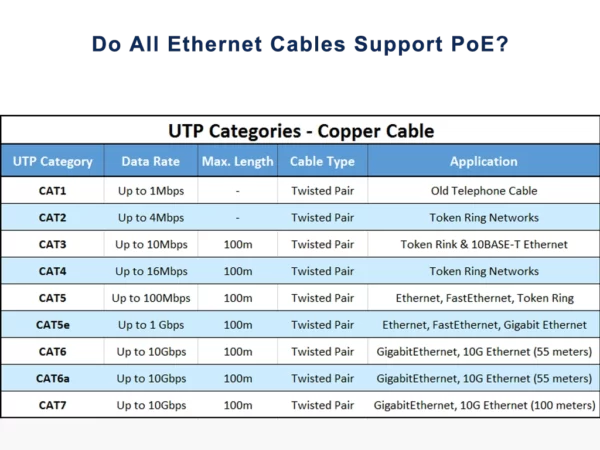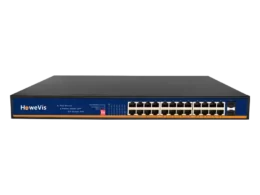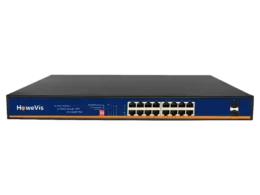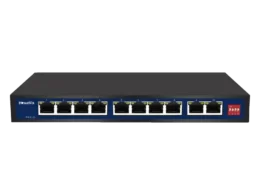No. All Ethernet cables don’t support PoE. The older versions of Ethernet ports have become redundant to support the new technology and provide power to electrical equipment. Before checking out the right equipment and Ethernet cable, you need to test whether they help or not.
We have multiple technologies at hand. PoE, WiFi, and similar technologies provide data connections in certain situations. But we must differentiate them at some point and explore their benefits. In this guide, we will analyze PoE technology in detail and elaborate on the different types of Ethernet cables available.
What is PoE technology, and how does it work?
Power over Ethernet PoE is a networking technology that contributes to:
- High-speed Data connection
- High power supply
You have different equipment, switches, and routers to work within a network. In such a network, you don’t only impose the data connection to transfer the data packets; you also have to charge your electrical equipment.
It is a revolutionary Power over Ethernet PoE that has stimulated a high power supply to charge the laptops, power screens, IP cameras, and surveillance devices connected to the network.
So, how does Power over Ethernet PoE work?
This mystery has yet to be disclosed. Power over Ethernet relies on the IEEE standards, which contribute to its working principles.
For example, there are three standards.
- IEEE 802.3af
- IEEE 802.3at
- IEEE 802.3bt
All of these have different power supplies and data speeds. For example, IEEE 802.3af provides around 15 watts of power, while IEEE 802.3bt delivers about 100 watts.
Overall, you can anticipate different functionalities from each PoE standard.
Suggested Reading: What is the PoE standard?
Concept of Ethernet Cable
Ethernet ports are unique except for cables that can assist in data transmission and power supply. Their main characteristic is their dual function of power and data transmission over the network.
So, what precisely is an Ethernet cable?
An Ethernet cable is a network cable that builds a connection between the PoE switch and your networking device, like an IP camera. All the power and data transmission occurs through twisted pairs of cables. These network cables can stimulate the PoE functionalities. Moreover, a twisted pair of Ethernet cables has:
- Cord or cable that is 100 meters long twisted pair cable.
- The connector at each is usually an RJ45 connector to insert it into the computer at one end and switch or router on the other end.
A twisted pair Ethernet port can be more than 100 meters long and support power and data transmission only if you use PoE extenders or other mechanisms.
Suggested Reading: What is the best Ethernet cable for PoE?
8 Fundamental Types of Ethernet Cables
Ethernet cables have multiple types supporting PoE devices and enabling data connection for decades. From 1980 to 2022, it is a long history of evolution, and you will expect better performance in the future.
Here are different categories of cables from the Ethernet technology.
Cat 1:
Cat1 or Category 1 Cable is an old Ethernet cable that was used in the 1980s. In its earliest days of inception, it was used to transmit data, but now, this functionality is redundant.
It is now suitable only for telephone communications and comprises an unshielded twisted pair of wires. Moreover, it is not an official Ethernet cable by the EIA or TIA.
Cat 2:
Like Cat1, Cat2 is an unshielded twisted pair of wires that is not an official category cable from the TIA. Now, it is possible to work with it in telephone and data communications. But, it is no longer in use.
However, it has a 4 Megahertz frequency with a maximum bandwidth of 4 megabits per second.
Cat 3:
Category 3 is the first category cable officially announced by the TIA for computer networking. It was used in the 1990s with the 10Base–T to deliver power and data over the Ethernet technology for the first time. It comprises the unshielded twisted pair(UTP) of wires often found in telephone wiring.
Since it has a bandwidth of 10 megabits per second, it is more reliable than Cat2 but less reliable than other versions, such as Cat 4 and Cat 5e. You can operate it with PoE 802.3af to get the PoE power over these pairs.
Cat 4:
You might not have heard about Cat4 more. Do you know why? It is less likely to be used to transmit power and data over Ethernet. Moreover, the Cat5 cable replaced the Cat4 due to its vast array of PoE applications.
However, TIA introduced the Cat4 as a replacement for the Cat3. It is an unshielded twisted cable pair with eight ports arranged in 4 pairs. It has a bandwidth of 16 megabits per second while the frequency is 20 megahertz.
Its applications include:
- Ring Network
- 10Base–T Ethernet
- 10Base–T4 Ethernet
Cat 5:
Cat5 and Cat5e are two versions discussed under Cat5. Cat5e is a variant of Cat5, so it is essential to differentiate between them.
Cat5 is a UTP cable transmitting data and power over these wires. It has a frequency of up to 100 MHz and was announced in 2001 as an official upgrade to the Cat4. Its applications include:
- Fast Ethernet — 100Base–T
- 1GB Ethernet — 1000Base–T
- PoE technology
It can support a network data speed of up to 100 meters.
Cat5e is a variant of the Cat5 with better features and upgraded functionalities. It has the same frequency features of 100 MHz but can efficiently work with the 10GB Ethernet technology. It can provide a data speed of up to 10 Gigabytes per second over 45 meters.
So, its applications include:
- PoE technology
- Fast Ethernet
- 1GB Ethernet
- 10 Gigabit Ethernet
If you are considering future systems, Cat5e is undoubtedly a better option with less interference and lower prices.
Cat 6:
Cat6 is an upgrade to Cat5. That’s why it has better bandwidth and facilities to utilize and enrich your connected networks.
Cat6 is a UTP cable with a frequency of 250 Megahertz. It has more stringent specifications for crosstalk and less interference. Not only can it work with Fast and 1GB Ethernet, but it can also provide power to PoE applications. Moreover, Cat6 functions with 10GB Ethernet over 55 meters.
Have you ever heard about the Cat6a Cable? If yes, it is a variant of Cat6 with better capabilities, the same as the Cat5e.
For example, the Cat6a cable has a higher frequency than the Cat6. The frequency of the Cat6a cable is 500 megahertz, twice as much as Cat6 has. Moreover, it can endorse the 10GB Ethernet up to 100 meters as every typical Category cable has a maximum distance.
However, I have listed the significant applications of the Cat6a cable.
- Fast Ethernet
- 1GB Ethernet
- 10GB Ethernet
- PoE 802.3af/at/bt
Suggested Reading: Can Cat6 do 10GB?
Cat 7:
Cat7 or Class F category cables are backward compatible shielded twisted pairs of cables supporting the high speed of data and enabling 10GB Ethernet up to 100 meters of distance. Cat7 has a frequency of 600 megahertz.
Its fundamental goal is to endorse 10GB Ethernet technology and achieve high data transmission speeds. TIA has not verified this version yet. However, the Cat7 cable was introduced in 2002.
Maybe you know an upgraded version of Cat7 called Cat7a. Am I Right?
It has some more functionalities and better backs the system. ISO Amendment 2 in 2010 modified and introduced Cat7a or Class F Augmented cables procuring a frequency of 1000 megahertz. The primary ambition of presenting Cat7a was to support 25 gigabytes per second data speed. However, it can support 25GBase—T, not 40Gbase—T, because we have the Cat8 cable with better features and specifications.
Cat 8:
Cat8, the latest Ethernet port, advocates higher data transmission due to its unique STP cables. It is backward compatible and uses the Standard RJ45 connector at the end of the Ethernet port to have a better chance.
The unique thing about Cat8 Ethernet cables is their shielding. They have a conductive material layer to reduce Electromagnetic interference(EMI) and make high data transmission possible.
Here are some peculiar features of the Cat8 Ethernet port.
- It has a bandwidth of 2 Gigahertz.
- The maximum frequency is around 2000 megahertz, more than all older Category cables.
- You can get the maximum data speed of 40 gigabytes per second in the 100-meter range.
-
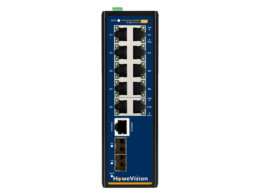 Industrial 12-Ports Gigabit L2+ Managed Ethernet switch
Industrial 12-Ports Gigabit L2+ Managed Ethernet switch -
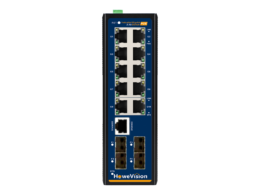 Industrial 14-Ports Gigabit L2+ Managed Ethernet switch
Industrial 14-Ports Gigabit L2+ Managed Ethernet switch -
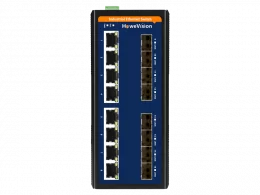 Industrial Gigabit Managed Ethernet Switch, 8-Ports 10/100/1000Base-TX RJ45, 8 Ports 100/1000Base-FX Fast SFP Uplink
Industrial Gigabit Managed Ethernet Switch, 8-Ports 10/100/1000Base-TX RJ45, 8 Ports 100/1000Base-FX Fast SFP Uplink -
 Industrial Gigabit Managed Ethernet Switch, 8-Ports 10/100/1000Base-TX RJ45, 4 Ports 100/1000Base-FX Fast SFP Uplink
Industrial Gigabit Managed Ethernet Switch, 8-Ports 10/100/1000Base-TX RJ45, 4 Ports 100/1000Base-FX Fast SFP Uplink
Which Ethernet cable can support PoE?
Support for the power over Ethernet relies on many factors like:
- Which PoE standard are you using?
- What is the data speed?
- How reliable is your network?
However, I can crack the code for the PoE-compatible Ethernet cable.
If you are using the PoE 802.3af, you require at least Cat3. Since this standard is redundant, you must employ at least Cat5 or Cat5e to get better PoE compatibility for your network switches.
Moreover, Cat5 or above versions are backward PoE compatible. That means you can use them with older PoE standards. So, the definitive version of the network cables is Cat5e for your PoE network.
2 Steps to test whether Ethernet Cable Supports PoE
Sometimes, you have network cables in your power over Ethernet system and want to ensure they are PoE compatible. For this reason, you need to follow the two steps below and determine whether it works with the PoE network.
It would be best to have the Cable Analyzer tool to determine the power over Ethernet compatibility.
Step 1: Execute Standard Cable Testing
Having the cable analyzer in your package would be best to execute the standard cable testing.
Run the analyzer through the standard Ethernet cable and check whether it passes the TIA/ISO field tests. It will be powered over an Ethernet-compatible standard Ethernet cable if it does. If the device fails, you need another Category cable for your PoE network.
Step 2: Check out Cable Resistance
Cable Resistance is another crucial aspect in determining whether four twisted pairs of Ethernet cables have the same resistance. Moreover, the above test does not show the opposition in each port.
According to Ohm’s law:
Voltage = Current X Resistance
According to the formula, you can derive high voltage supports and high power with high resistances. It is what we believe that high PoE power provides.
However, you can test the cable resistance in all four twisted pairs of cables. If all four twisted pairs have the same resistance, it can work with PoE++ and high PoE power over the network.
In other cases, it is never suitable. For PoE compatibility, you can use a PoE injector or any other option.
EndNote
Do you need to use power over Ethernet in your networks? If so, ensure you have a Cat5e Ethernet port and PoE-compatible devices to work. Otherwise, you might need an injector to make the non-PoE devices PoE enabled.
However, suppose you want to purchase inventory related to Gigabit Ethernet, PoE-enabled devices, PoE injectors for non-PoE devices, and many more products. In that case, HoweVision Professional has all the equipment available for you. You can immediately contact us and get twisted pairs of cables for your Ethernet technology!

